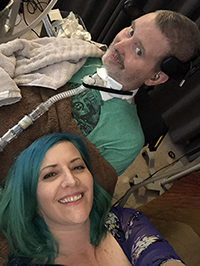Five Medications to Help with Excess Saliva (ALS or other diseases)
Disclaimer: We are not doctors and this is in no way medical advice. All information held within this post and on this site are meant for educational purposes only. We’re providing information based on our own research and experiences with ALS, and what works for Brian. *Consult your physician before consuming anything shared here.*
Excess Saliva
Saliva and secretion management is a common challenge among ALS patients (PALS). The medical term is sialorrhea, which is actually a loss of control of saliva. Individuals with ALS don’t produce more saliva than other people, but they can have trouble maneuvering their mouth to swallow it. PALS can become unable to control the saliva from coming out of their mouth while also having a difficult time swallowing their saliva. We’re just going to call it what it is for ease…drooling. (Brian said it was OK!)
In the early stages of Brian’s drooling we were able to manage it with paper towels here and there. It then became a process of using the suction machine with a Yankauer suction handle, shown here.
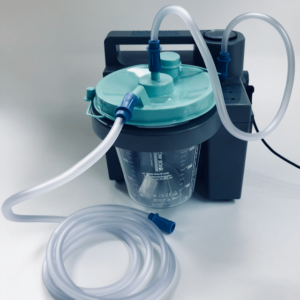
DeVilbiss Suction Machine
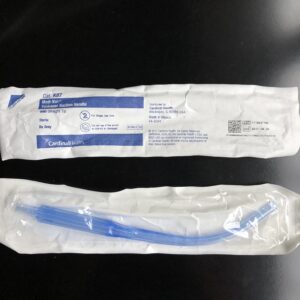
Yankauer suction handle.
That worked for awhile, then it got to the point where it was out of control and we didn’t know what to do. Before we found a medication that worked for Brian, there were long days where I would stand beside him and suction for up to two hours at a time. Even our ALS clinic wasn’t very helpful in recommending medicines that worked. (The clinic tends to be more research focused.)
As Brian’s ALS has progressed his his ability to swallow is almost to the point of being non-existent. This has meant that secretion management is an added part of his caregiving routine. Without something to manage it, some days can get really tough, certainly for the PALS but also for the caregiver.
Here are five medications to consider and talk to your physician about.
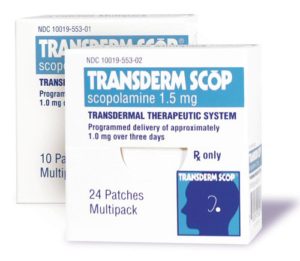
1. Scopolamine
Transdermal patch
Recommended adult dosage – 1.5 mg / 72 hours
-
- We know the most about these patches as they are the only thing that seem to help with Brian’s secretions.
- These small circular patches are less than an inch. They look like little round Band-Aids and are often also used for motion sickness.
- Patches come in a dosage of 1.5 mg for 72 hours.
- Dosages may vary per patient. Brian is now using one patch every other day.
- Transderm Scop is the brand name for this patch. Here is a link to the manufacturer site for more info.
- One issue with this medication is that it is very expensive. There is now a generic form of the patch as well. (The manufacturer is Perrigo.)
- Also, it can often be an elusive drug, in that your pharmacy might not have it. Call your pharmacist to discuss as soon as secretions become excessive enough to need a suction machine. Even if the patch isn’t needed just yet, it’s good to advise that the need is coming.
- While the patches work well they are not immediate relief and do take some time to really kick in. Up to a few hours in most cases.
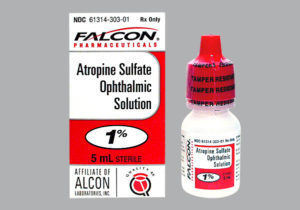
2. Atropine
Sublingual liquid
Recommended adult dosage – 1% strength / 2-3 drops up to 3x per day
- This liquid comes in a little bottle. Ask your pharmacist for a plastic dropper if not included.
- From drugs.com – “Atropine is used to help reduce saliva, mucus, or other secretions in your airway during a surgery. Atropine is also used to treat spasms in the stomach, intestines, bladder, or other organs.”
- Getting drops under a PALS tongue can prove to be quite the challenge. Some PALS may not be able to open their mouth very wide. A long, thin plastic syringe or dropper works best.
3. Levsin®
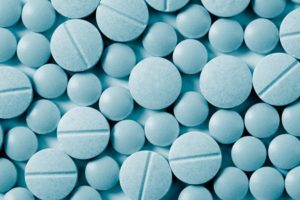
Sublingual or oral pills
Recommended adult dosage – 0.125 mg / 1 to 2 tablets every four hours or as needed. Do not exceed 12 tablets in 24 hours
- These pills come in bottles of 100 or 500.
- From rxlist.com – “Levsin® (hyoscyamine) inhibits gastrointestinal propulsive motility and decreases gastric acid secretion. Levsin® (hyoscyamine) also controls excessive pharyngeal, tracheal and bronchial secretions.”
- Pill(s) are placed under a PALS’ tongue. As with sublingual liquid, this can be a challenge, depending on the PALS.
- A few nurses have told us that we can crush the Levsin and administer it through the feeding tube. If you have a tube, remember to remind the doctor or nurse, as they don’t always keep that in mind when ordering the meds, and be sure to check with your pharmacist for how to administer any drug.
4. Robinul (Glycopyrrolate)
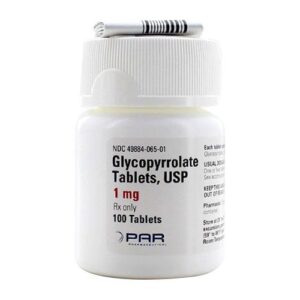
Pill, Injection, Oral Liquid
Recommended adult dosage – Varies depending on type, consult physician
- Oral liquid
- This can be challenging depending on the PALS
- From WebMD – Glycopyrrolate solution is used to reduce excessive drooling caused by certain medical conditions. This medication works by decreasing the amount of saliva you produce. Glycopyrrolate belongs to a class of drugs known as anticholinergics.
- Take as directed by your doctor / pharmacist.
5. Botox®
Injection
- Some PALS have experienced success managing secretions using Botox injections.
- We list it here only as a resource for awareness, yet our research has found that there are many risks and adverse side effects associated with this method.
- Discuss this option with your specialists before proceeding.
- The FDA also recently approved Xeomin which is similar to Botox.
Thinning Secretions (Added Tip!)
In addition to trying to dry up secretions, it can also help to thin out the secretions as well. This can make them a little easier for PALS to manipulate in their throat and mouth and also makes suctioning a little easier. We were relying on Mucinex every four hours in the beginning, before we tried other, prescription, meds. We still use it from time to time when Brian’s secretions get thick and out of control. The key ingredient here is the guaifenesin.
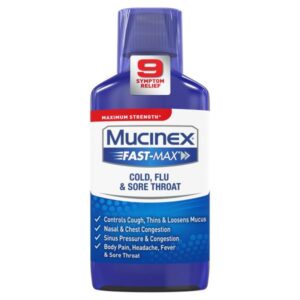
Mucinex can help to thin secretions.
There are other medications to help with thinning secretions, such as Albuterol, Mucomyst or DuoNeb. These medications get administered through a nebulizer. A nebulizer is a machine that transforms the liquid medication into a mist. The mist is then inhaled through a special device or mask.
Good Luck!
While this list is not exhaustive, these are some of the most common medications and ones we’ve tried for Brian. Hopefully this helps at least a little bit!
Disclaimer: We are not doctors and this is in no way medical advice. All information held within this post and on this site are meant for educational purposes only. We’re providing information based on our research and experiences with ALS, and what works for Brian. *Please consult your physician before consuming anything shared here.*

